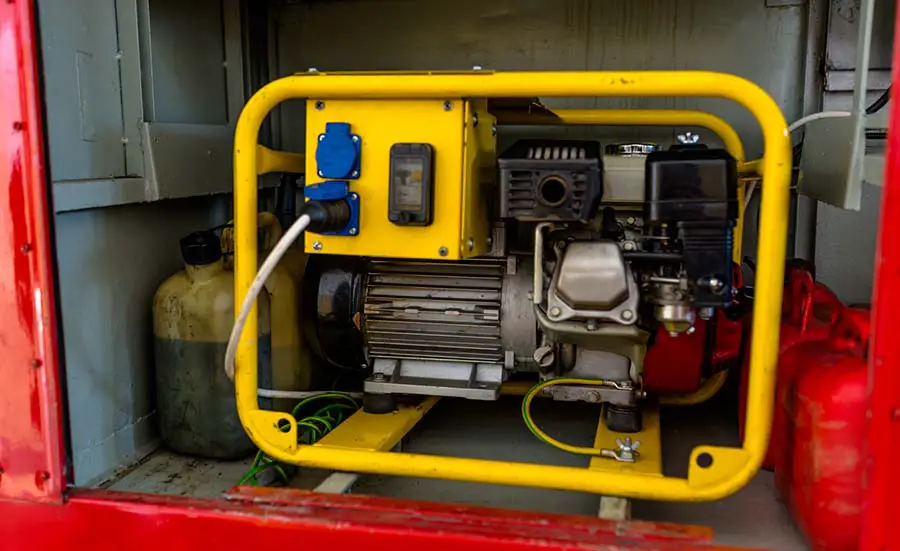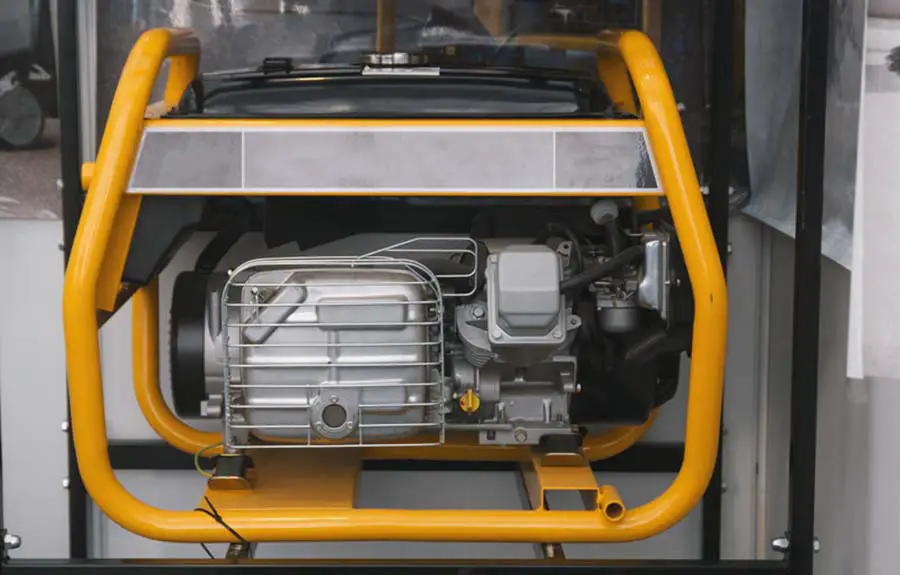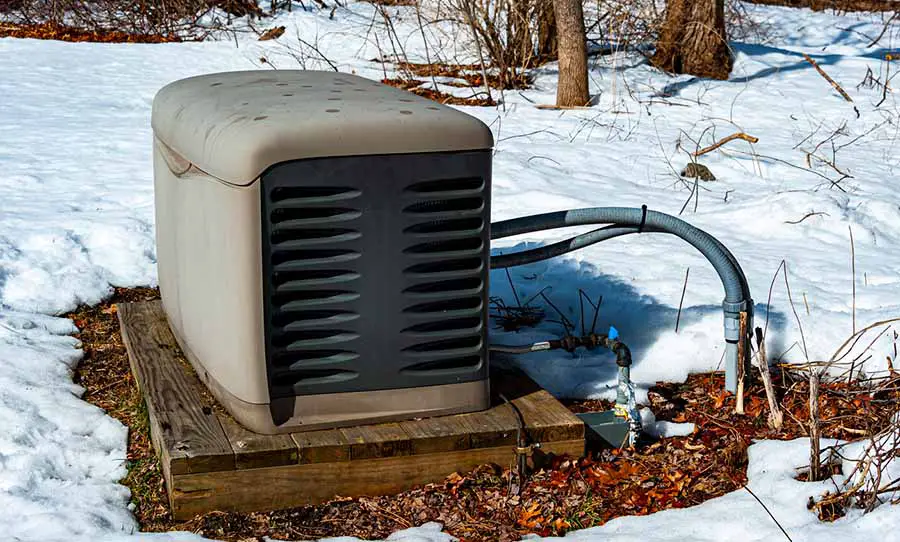
A generator is a handy and often necessary tool to have when your power supply does not work anymore. Generators are traditionally used for backup power at hospitals and office blocks and are becoming more and more necessary to the homeowner as a means of alternate power.
There are many places to put your generator when not being used every day safely. Easy access is key to storing the generator for later use.
- Housing outside your home or building
- Storage sheds
- Steel enclosures
- Generator tents
- Housing in a garage
- Mounting on a trailer
As generators come in all sizes and shapes, finding the correct place to house them is a serious question to consider before investing in one for your home or office. Most hospitals and emergency rooms already have rooms built to house a generator as necessary equipment. However, many homes and office blocks do not have generator storage in mind, so where should you safely house your generator?
The Safest 6 Places To House A Generator
Before deciding where to place your newly acquired generator, check the legal requirements for your state. Rules differ from city to city, and you could receive a hefty fine if you do not comply with the rules for your area.
Check the manufacturer’s requirements for your particular generator, as some do have specific installation requirements. Always contact a professional to assist with the installation of your generator.
Now that you have taken care of the legal aspects of owning a new generator, let’s look at safe places to house it.
1. Housing Your Generator Outside Your Home or Building
The ideal location for a generator is a place that allows the generator to operate efficiently and safely to get the job done without endangering lives. Portable and standby generators have different needs, which we’ll discuss below.
Portable Generators
A portable generator is entirely safe when you follow the manufacturer’s instructions for where to place it. If you are renting a generator, follow the placement and storage instructions from the rental company.
Generally, the rules for portable generators are:
- A portable generator should always be outside your home or building.
- Place the generator in a position that will keep your home or building safe from fumes or theft – it should be at least 20 feet (6 meters) from the building.
- Do not place directly outside an open window, vent, or door.
- Place the generator in a position that blows the exhaust fumes away from your home and not into it. Be aware of your neighbor’s windows and doors, and don’t allow the fumes to be blown in the direction of their house.
- Consider the noise that the generator makes and don’t place near doors or windows to either your home or your neighbor’s homes.
- Place the generator away from areas frequented by people, traffic, and pets.
Standby Generators
When deciding where to house a standby generator permanently, you should consider the same factors as a portable generator. The only difference when deciding where to place a standby generator is that it will be permanent.
You will need permission from your local housing authority to install a concrete pad for the generator to sit on. Once you have the required permission, follow these rules when installing a permanent standby generator:
- A permanent standby generator should always be outside your home or building on stable ground or on a concrete pad.
- Check the rules with the gas company as to what their clearance requirements are from the building – standard requirements are 5 feet (1.5 meters) from the closest window or door.
- Do not place directly outside an open window, vent, or door.
- Place the generator in a position that blows the exhaust fumes away from your home and not into it. Be aware of your neighbor’s windows and doors, and don’t allow the fumes to be blown in the direction of their house.
- Consider the noise that the generator makes and don’t place near doors or windows to either your home or your neighbor’s homes.
- As a rule, keep the permanent generator away from areas close to pathways, playgrounds, and roads.
2. Storage Sheds for Your Standby Generator

Storage sheds are for storing almost anything in your backyard. A shed made from durable resin or wood is the perfect place to store and run your portable generator from. Building a shed for your generator can be soundproof and weatherproof if you use the right materials.
Build the shed big enough for ventilation on all sides. Ensure that the shed has windows and double doors that swing open before you buy and erect it. The ventilation is what makes the shed an ideal place to house and run your portable generator from.
When you are not using the generator, you can house it can go safely in the shed. Make sure that all openings close tightly to protect the generator from the elements. Install locks to protect your generator from thieves.
When you are not using the generator, and if you are going to run it from the shed, do not leave it unattended as the generator produces a lot of heat, and the shed could get damaged. You need to be available to switch off the generator if it gets too hot and overheats the shed.
3. Steel Enclosures for All Generators
A steel enclosure can be an excellent option for housing your standby or portable generator. It can be a permanent structure far enough away from your home or building to prevent fumes and noise from being a nuisance but close enough for easy access.
You can make a steel shed to fit the type of generator you have, protect the generator from the elements, and lock it up to prevent theft.
Make sure that there are enough windows and doors to provide the required ventilation when running the generator.
4. Generator Tents for Your Portable Generator
Gen tents, as they are called, are portable canopies designed for use with your portable generator. A Gen ten does not restrict the airflow required by the generator or hamper the operation in any way. A Gen tent is cheaper than a shed but should not be used to store your generator.
You use a Gen tent to keep your portable generator safe from sleet, snow, rain, and wind while being used outside and away from home. A Gen tent is by no means intended to be a permanent structure or shelter for your generator.
A Gen tent is an excellent option for campers as it will keep the generator running through all kinds of weather.
5. Running a Generator From a Garage
You can easily run a generator from a detached garage as long as it is well ventilated, but be careful of running your generator from an attached garage with the doors closed.
The danger of having no ventilation is carbon monoxide poisoning which could seep from your garage into the rest of your house. Only run your generator if your garage is at least 15 feet (4.5 meters) from your home; otherwise, move the generator outdoors before you use it.
To try and prevent the noise produced by the generator, you can install a soundproof baffle box. This is a box lined with vinyl, fiberboard, acoustic caulking, and glue sealant to muffle and reduce the sound from a generator.
This will make the generator quieter for you and prevent your generator noise from annoying the neighbors.
6. Mounting a Portable Generator To a Trailer
This is an excellent option for campers and anyone who needs to use a portable generator in a hurry! You would need a strong, sturdy trailer capable of carrying the additional weight of the portable generator that you have bought.
Do the research to see which option would suit your type of trailer and portable generator. Unique mounting frames are available for trailers for fitment either on the front or the back of the trailer.
An advantage to having a generator mounted on a trailer is that it is portable and always ready for use. You know where it is and have instant access to it when needed. You may have to rig up a weatherproof cover to keep it safe from the elements when not in use or when traveling.
Make sure that you follow the rules for the placement of the generator when you do need to use it.
Things To Consider Before Housing Your Generator

A generator is an instrumental piece of equipment to have available for any household. It is not a piece of equipment with exclusive use in the off-grid application because you can use it in urban and suburban settings.
Power grid failures and blackouts can happen anywhere at any time, for several reasons, from bad weather to poorly maintained infrastructure to civil unrest. Any of these situations could result in the loss of power supply to your home and negatively affect your household and lifestyle.
When deciding where to place a generator safely, you should answer the following questions first as to why you need a generator and where you will put it. Research has shown that many people buy a generator without doing any research and end up with a generator that does not fit into their space.
1. What Will You Use a Generator For?
Choosing the correct generator for your needs is not easy and requires some research to find the right one. Most standby generators are used to power a building and offer essential services during a power outage, while others are used permanently as an alternative power source.
Portable generators can be used to power your home or can be used off-site by tradesmen or emergency workers. Portable generators are often used in emergencies to provide light or to power tools.
Consider what the generator needs to power – appliances, computers, lights, etc., before deciding on which size generator to buy.
2. Do You Need a Standby Or a Portable Generator?
A standby generator is permanently connected to a home’s power supply and automatically swops over in a power outage.
You can move a portable generator to where it is needed. It generally runs off of gas or solar power but requires manual intervention to run it. A cable runs from the generator to supply all your devices and appliances with the power they need to run.
3. What Size Generator Do You Need?
The size is determined by what you need to operate during the power outage. Do you need to power an entire office block or only a few essential appliances in your home?
You need to consider how much noise the generator will make and the number of fumes produced by the machine. A generator emits poisonous carbon monoxide fumes, so you need to place it in a well-ventilated area.
The larger the generator, the noisier it will be, so consider your neighbors when choosing a generator.
4. What Is Going To Power Your Generator?
A generator requires fuel to work; the bigger the generator, the more fuel it will use. Gasoline generators are the most common due to their size and cost-efficiency. Diesel generators are more expensive than gas generators, but they have better fuel efficiency and a longer life span.
Other options are solar, propane, and biogas fuelled generators. Deciding which generator you will use and the installation requirements will determine where you place the generator.
Safety Tips For Your Generator
We have discussed a few places where you can safely house your new generator, but what about places where we should not house it at all?
- Never run your generator inside your house, under your porch, or in your basement, due to the risk of escaping poisonous carbon monoxide fumes. As a rule, every dwelling with access to a generator should have a carbon monoxide detector.
- Another place to not locate your generator is under an overhang, in a breezeway, or in a recess blocked by vegetation, shrubs, or trees.
- Don’t house your generator inside a doghouse!
- If you run your generator while camping, make sure that it is used in an open area, and remember carbon monoxide poisoning!
- Always make sure that you have housed your generator in a safe place and that you comply with all the necessary safety precautions as recommended by the manufacturer.
- Never start your portable generator with power cords attached. Only attach the power cords after you have started the generator.
Conclusion
You can use a generator to provide lighting, safety, warmth, and the power necessary to run appliances or provide emergency services during power outages. In some circumstances, it could mean the difference between life and death, losing your food supply, or simply the ability to stay warm.
The best way to use the generator is according to the manufacturer’s instructions. The manual will advise the correct installation and operating procedures for your specific generator model. The storage of the generator is an essential aspect of the care and maintenance of the unit and will make sure that the generator will be in good working condition when you need it the most.
Using the generator must always be done with safety in mind. This includes using the generator in locations that will not pose a fire hazard or cause possible fatal electric shocks.
Always make sure that you use your generator safely with the necessary ventilation to prevent carbon monoxide poisoning.

